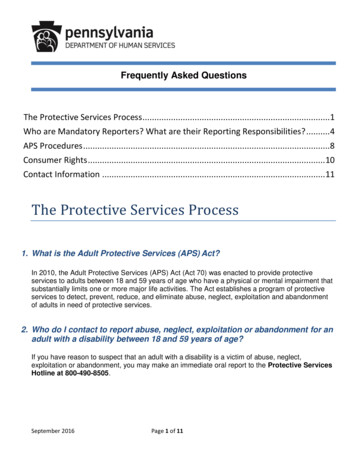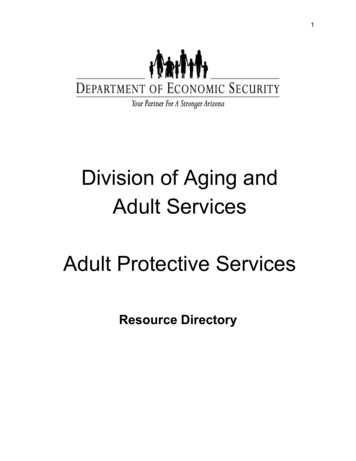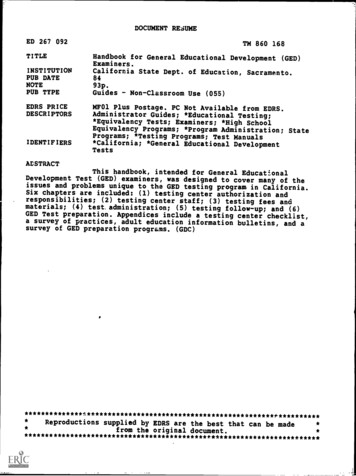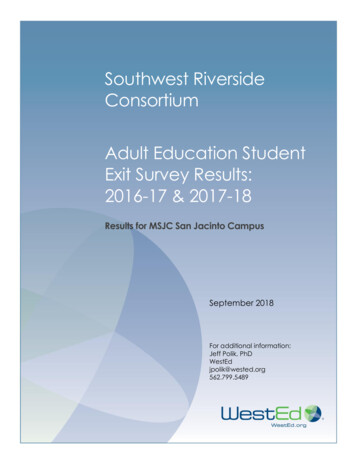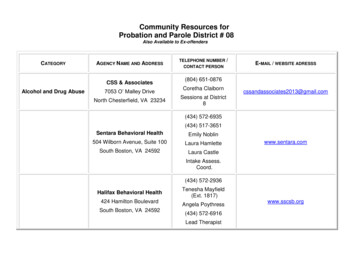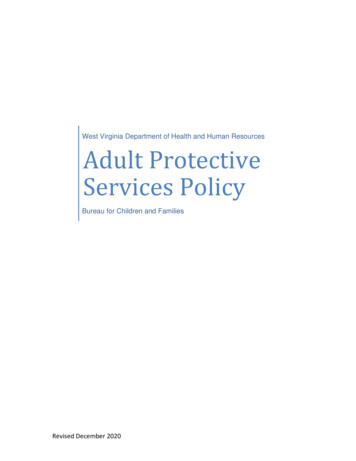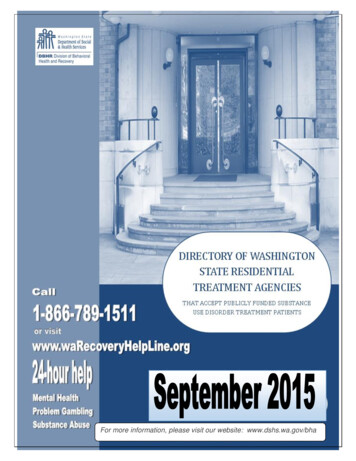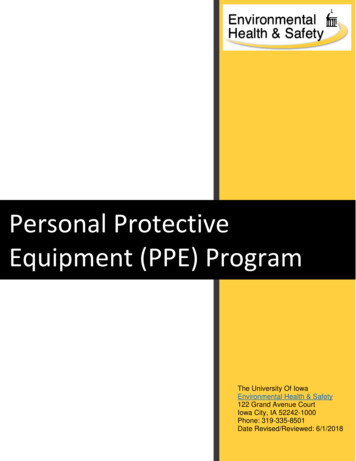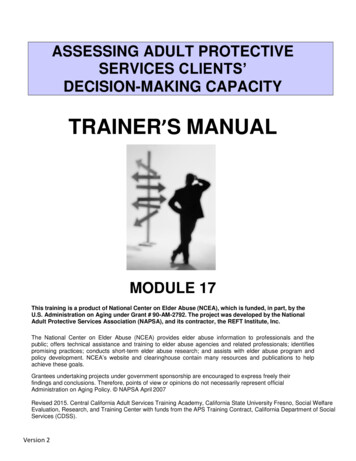
Transcription
ASSESSING ADULT PROTECTIVESERVICES CLIENTS’DECISION-MAKING CAPACITYTRAINER’S MANUALMODULE 17This training is a product of National Center on Elder Abuse (NCEA), which is funded, in part, by theU.S. Administration on Aging under Grant # 90-AM-2792. The project was developed by the NationalAdult Protective Services Association (NAPSA), and its contractor, the REFT Institute, Inc.The National Center on Elder Abuse (NCEA) provides elder abuse information to professionals and thepublic; offers technical assistance and training to elder abuse agencies and related professionals; identifiespromising practices; conducts short-term elder abuse research; and assists with elder abuse program andpolicy development. NCEA’s website and clearinghouse contain many resources and publications to helpachieve these goals.Grantees undertaking projects under government sponsorship are encouraged to express freely theirfindings and conclusions. Therefore, points of view or opinions do not necessarily represent officialAdministration on Aging Policy. NAPSA April 2007Revised 2015. Central California Adult Services Training Academy, California State University Fresno, Social WelfareEvaluation, Research, and Training Center with funds from the APS Training Contract, California Department of SocialServices (CDSS).Version 2
ASSESSING CAPACITY – TRAINER’S MANUALThe National Center on Elder AbuseThe Source for Information and Assistance on Elder AbuseThe Center is administered by the U.S. Administration on Aging. During the developmentof this product, the National Association of State Units on Aging served as the lead agencyfor the Center, funded by grant No. 90-AP-2144 from the U.S. Administration on Aging.Under this grant, the NCEA consisted of a consortium of five partner organizations:PARTNER ORGANIZATIONSSara Aravanis, DirectorNational Center on Elder AbuseNational Association of State Unitson Aging1201 15th Street, NW, Suite 350Washington, DC 20005-2800(202) 898-2586 / Fax: (202) 898-2583NCEA@nasua.orgLori Stiegel, Associate Staff DirectorCommission on Law and AgingAmerican Bar Association740 15th Street, N.W.Washington, DC 20005-1022(202) 662-8692 / Fax: (202) 662-8698lstiegel@staff.abanet.orgKathleen Quinn, Executive DirectorNational Adult Protective Services Association920 South Spring Street, Suite 1200Springfield, IL 62704(217) 523-4431 / (271) 522-6650Kathleen.quinn@apsnetwork.orgRandy Thomas, PresidentNational Committee for the Prevention of ElderAbuseC/o Matz, Blancato & Associates1101 Vermont Avenue, NW, Suite 1001Washington, DC 20002(202) 682-4140 / Fax: (202) 682-3984ncpea@erols.comKaren Stein, DirectorClearinghouse on Abuse andNeglect of the Elderly (CANE)University of DelawareSchool of Urban Affairs and Public Policy182 Graham HallNewark, DE 19716(302) 831-3525 / Fax: (302) 831-3587kstein@udel.eduNational Center on Elder Abuse - www.ncea.aoa.gov-2Version 2
ASSESSING CAPACITY – TRAINER’S MANUALACKNOWLEDGEMENTSPROJECT DIRECTORJoanne M. Otto, MSWExecutive DirectorNational Adult Protective Services AssociationCONSULTANTSBonnie Brandl, MSWNCALL Project DirectorWisconsin Coalition Against Domestic ViolenceSusan Castaño, MSWAdult Protective Services ConsultantAnne KincaidProject CoordinatorDora G. Lodwick, PHDExecutive DirectorREFT Institute, Inc.Alexandra Mitchell, MPAREFT Institute, Inc.Mary Joy Quinn, RN, MADirector of Probate Court SanFrancisco Superior CourtPatricia Stanis, PHDAdult Protective Services ConsultantCurriculum Revisions 2015Krista BrownCopyright information: Copies of this document may be made without permission. It isrequested that proper credit be given to the developer and those organizations thatsponsored the development of these materials.This waiver of copyright by NAPSA does not apply to any copyrighted materials thatNAPSA used with permission of other authors.-3Version 2
ASSESSING CAPACITY – TRAINER’S MANUALTABLE OF CONTENTSGeneral InformationNational Center on Elder Abuse2Acknowledgements3How to Use This Manual4Course Outline6Training Goal and Objectives7Trainer Guidelines8PresentationWelcome and Introductions . 9Overview & Key Terms of Capacity Assessment . 18Factors Affecting Capacity . 28Case Study Activity #1 . 49Capacity Assessment: Domains and Tools . 62Capacity Screening Skills . 92Case Study Activity #2 . 102Cross-Cultural Interviewing & Assisted Capacity . 111Case Study Activity #3 . 121Closing. 128References & Resources 133AppendixCore Competencies for APS Workers . 137-4Version 2
ASSESSING CAPACITY – TRAINER’S MANUALHOW TO USE THIS TRAINING MANUALThe course outline, provided in the next section of this manual, is the class schedule usedduring the piloting of this training. It can be used to help you determine how much time youmight need to present each section. However, times will vary based on the experience andengagement of your audience.Customizing the PowerPoint:Once you decided on how you want to divide up your time in presenting this material, you maywant to customize your PowerPoint. The Microsoft Office PowerPoint software allows you tohide any slides you don’t want to use.Hide a slide instructions1. On the Slides tab in normal view, select the slide you want to hide.2. On the Slide Show menu, click Hide Slide.The hidden slide icon appears with the slide number inside, next to the slide youhave hidden.Note: The slide remains in your file, even though it is hidden when you run thepresentation.Please note that this manual is set up so that the trainer script/ background material is on thesame page as the accompanying PowerPoint slide making it easy to also customize yourmanual to match the slides you have decided to use, Just remove the unneeded pages.You may also decide to add slides showing specific program information, policies or proceduresfor your agency or jurisdiction. This will increase the applicability of the training but care must betaken not to try and pack too much additional content into the training.NOTE: If you wish, you can individualize the PowerPoint slides by adding information inthe “notes” section of each slide-5Version 2
ASSESSING CAPACITY – TRAINER’S MANUALCOURSE OUTLINEContentTotal TimeActivitiesWelcome and Introductions20 min.Lecture/introductionOverview & Key termsof capacity assessment25 min.Factors affecting capacity45 min.BREAK15 min.Case Study Activity#130 min.Capacity AssessmentDomains & Tools (lunchbreak)75 min. 60 min lunchCapacity Screening Skills30 min.Case Study Activity#230 min.BREAK15 min.Cross cultural interviewing &Assisted Capacity15 min.Case Study Activity#345 min.Closing15 min.TOTAL TIMELectureDiscussionLectureLarge groupactivityVersion 2Slide 15-24Handout #2-6Slides 25Handouts: Casestudies 1-5LectureDiscussionSlide 26-41Handouts: #7-12Slides 42-44Handout #13Small groupactivitySlide 45Handouts: Casestudies 1-5LectureDiscussionSlides 47-53Handout #14Small group activityLarge groupdiscussionsQ & A,Optional: Post-test,answers, andevaluation-6-Slides 6-14Small groupactivityLectureDiscussion7 hrs.Slides/handoutsSlides 1- 5Optional: Handout #1Appendix: APS CoreCompetenciesSlide 54Handouts: Casestudies 1-5Slide 55Optional:Handouts #15-17
ASSESSING CAPACITY – TRAINER’S MANUALTRAINING GOAL AND OBJECTIVESGoal: The purpose of this workshop is to assist Adult Protective Services professionals inidentifying the factors that affect their clients’ decisional capacity, and to identify when toseek a professional evaluation.Objectives: Upon completion of this training session, participants will be better able to:1. Define autonomy, capacity, and incapacity.2. Describe factors that may influence client capacity.3. Describe signs and symptoms that indicate capacity issues.4. Identify key questions and approaches used to screen client capacity, includingworking with special populations.5. Identify implications for case planning as a result of a finding of limited capacity.-7Version 2
ASSESSING CAPACITY – TRAINER’S MANUALTRAINER GUIDELINESTeachingStrategiesThe following instructional strategies are used: Lecture segments Interactive exercises (e.g., case study, large and small groupdiscussions) Question/answer periods Power Point Slides (slides with an * have notes on them in theappendices) Participant guide (encourages interaction with the contentinformation), including resources Pre-/post-tests to assess learning (optional) Evaluation to assess training process (optional)The following materials are provided and/or recommended:MaterialsandEquipment Computer with LCD (digital) projector CD-ROM containing slide presentation for module Easel/paper or post-it sheets/markers/masking tape Trainer Guide: This guide includes the course overview,introductory and instructional activities, and an appendixcontaining reference materials. Participant Guide: This guide includes a table of contents,course introduction and all training activities. Nametags/name tents-8Version 2
ASSESSING CAPACITY – TRAINER’S MANUALCOURSE 02:002:302:453:003:454:00Welcome and IntroductionsOverview & Key TermsFactors Affecting CapacityBreakCase Study Activity #1Capacity Assessment: Domains & ToolsLunchCapacity Assessment: Domains & ToolsCapacity Screening SkillsCase Study Activity #2BreakCross-Cultural InterviewingCase Study Activity #3Closing/EvaluationsEnd of TrainingINTRODUCTION TO TRAINING MANUALTrainer Instructions - The following guidelines will assist you in preparing for a successfultraining:1.2.3.4.Limit class size to 30 personsSet up the classroom into "pods" (e.g. table groups) of 5-6 participantsPrepare flip chartsReview Case Study Activities 1-3-9Version 2
ASSESSING CAPACITY – TRAINER’S MANUALPRESENTATIONVersion 2- 10-
ASSESSING CAPACITY – TRAINER’S MANUALWELCOME AND INTRODUCTIONSTIME ALLOTTED: 20 minutesSlide 1: Welcome to Assessing Adult Protective Services Clients’ Decision-Making Capacity. Introduce yourself by name, job title, organization and qualifications as Trainer. REVIEW GUIDELINES: There will be two 15-minute breaks and an hour for lunch today: Use the restrooms whenever you need to do so. The restrooms are located at .Please turn off your cell phones for the duration of the training. If you mustmake or receive a call, please leave the training room and return as quickly aspossible. Check the course outline to see what you have missed.CONTINUEDVersion 2- 11-
ASSESSING CAPACITY – TRAINER’S MANUAL PARTICIPANT INTRODUCTIONS:Ask participants to: make a brief self-introduction including name, job title, organizationrespond, in 1 or 2 sentences, to the following question:What are your challenges when trying to determine capacity or to decide when it istime to call in the experts?NOTE: Record answers onto a flip chart, so you can refer to them as the day goes on.This will provide information on the participants’ expectations. It will also get theminvolved from the beginning, validate their issues, and help to guide the Trainer’s focus.OPTIONAL: REMIND Participants OPTIONAL HANDOUT #1: Pre-testPrior to this event, you were sent written confirmation of your registration forthe training, along with a pre-test. You were asked to complete the pre-testbefore coming to the training.At the end of today’s training, please complete the post-test.The assigned numbers on the tests are used to compare your knowledgebefore attending the training and after you have completed it.The tests are used only to measure the effectiveness of the training.TRAINER NOTE: Both the Pre and Post Tests and answer key can be found inthe Appendix Guide.Adult learners often want a measure of how much they have learned from aworkshop. Pre and post-tests are useful tools for them to assess their ownlearning. Workshop sponsors and Trainers also find this tool useful to assess theirimpacts. As the Trainer, it is your choice whether and how to use the pre and posttests. Modify the directions you give participants based on your decision.Version 2- 12-
ASSESSING CAPACITY – TRAINER’S MANUALHANDOUT #1 (Optional) Pre-testTest #1. What is the difference between an APS assessment of capacity and a professionalcapacity evaluation?2. True or False (circle one) “Incapacity” is a medical term used to describe a person’sinability to make decisions.3. Autonomy involves all of the following except one (please circle the incorrect option):a)b)The person’s rightsThe person’s choicesc)d)The person’s responsibilitiesThe person’s capacity4. Once a person is judged incapacitated, he or she may lose the right to: (Circle thecorrect answer[s].)a) Make decisions regarding medical careb) Have a guardian appointed by the courtc) Have a conservator appointed by the courtd) Enter into contract agreementse) Chose his/her place of residence5. List 4 factors that may influence the decision-making capacity of an adult.a)b)c)d)6. What are the four (4) components used when assessing a person’s capacity?a)b)c)e)7. List a strength and a limitation of a standardized capacity assessment tool, such as theFolstein Mini-mental Status Examination.8. List 3 questions that could be asked of the client when assessing his or her capacity.a)b)c)9. On the back of this page, list two special accommodations that are necessary whenassessing the capacity of: 1) a person with a disability (such as a hearing impairment),or 2) who speaks no English, or 3) who is non-verbal.- 13 Version 2
ASSESSING CAPACITY – TRAINER’S MANUALSlides 2 & 3TOPIC: Funders & NAPSA The National Center on Elder Abuse (NCEA) underwrote this module. NCEA is a Centerfor information and assistance on elder abuse. This training was developed by NAPSA with the REFT Institute. Joanne Otto was theproject director. National Adult Protective Services Association:o NAPSA is the only national organization which represents APS professionals,programs and clientso NAPSA is the National Voice of APSo NAPSA is a partner in the National Center on Elder Abuseo NAPSA has members in all 50 stateso http://www.napsa-now.org/- 14 Version 2
ASSESSING CAPACITY – TRAINER’S MANUALSlide 4NAPSA CoreCompetency List inparticipant manualon page 90TOPIC: NAPSA APS Core Competencies This training is part of 23 practice-based modules that comprises a full set of corecompetencies for Adult Protective Services (APS) caseworkers. These NAPSA core competencies were identified by APS practitioners in a series ofnational meetings and work sessions held from 2003 to 2005. The 23 core training modules were developed by the National APS TrainingPartnership led by NAPSA and MASTER/Academy for Professional Excellence. The trainings cover the basic information that all APS caseworkers need to know inorder to intervene in the lives of the elderly and persons with disabilities, who arevictims of abuse, exploitation or neglect. Module 17 is general enough to be useful to anyone who is conducting basic APStraining. More information about NAPSA Core Competency trainings can be found g/core-aps-competencies/- 15 Version 2
ASSESSING CAPACITY – TRAINER’S MANUALSLIDE 5TOPIC: Training Goal The goal of this training is to assist Adult Protective Services professionals inidentifying the factors that affect clients’ decisional capacity, and in knowing whenand how to seek a professional evaluation. Trying to decide if clients have the ability to make informed decisions about theirsituations and care is one of the greatest challenges faced by APS workers. APS caseworkers are able to assess clients’ situations and how they are functioning.They do this very well. Only those licensed clinical social workers who have received specialized training,have gained special experience or both, have the credentials to conductprofessional capacity evaluations. Others who may be qualified are psychologists, geriatricians, or psychiatrists.The goal of this training is NOT to enable APS caseworkers to conductprofessional capacity evaluations.- 16 Version 2
ASSESSING CAPACITY – TRAINER’S MANUALSLIDE 6TOPIC: Learning objectives.The learning objectives which will be covered in this training module:1. Define autonomy, capacity, and incapacity.2. Describe factors that may influence client capacity.3. Describe signs and symptoms that indicate capacity issues.4. Identify key questions and approaches used to screen client capacity, includingworking with special populations.5. Identify implications for case planning as a result of a finding of limited capacity.- 17 Version 2
ASSESSING CAPACITY – TRAINER’S MANUALOVERVIEW & KEY TERMS OF CAPACITYASSESSMENTTIME ALLOTTED: 25 minutesSLIDE 7TOPIC: What is autonomy? “Autonomy” means the right to make one’s own decisions (Kemp 2005). Understanding the concept of autonomy is essential for APS caseworkers, since oneof your primary responsibilities is to honor and protect your clients’ autonomywhenever possible. Knowing how a client demonstrates the ability to make informed decisions isinformation you must have in order to understand if there are problems in this area.TRAINER NOTE: Kemp, Bryan, Ph.D. has worked in geriatrics, geriatric mental healthand rehabilitation for over 30 years, evaluating clients who are alleged victims of elderabuse and lecturing on evaluation of client capacity, causes of vulnerability and financialabuse.- 18 Version 2
ASSESSING CAPACITY – TRAINER’S MANUALSLIDE 8TOPIC: What is decisional capacity? Decisional capacity is a complex concept. Decisional capacity is the ability to adequately process information in order tomake a decision based on that information (Kemp 2005). The definition used here has been chosen because it is simple, comprehensive andeasy to remember. Types of decisions – include medical/personal care; sexual/relationship;contractual; testamentary (e.g. creating a will); and research participation- 19 Version 2
ASSESSING CAPACITY – TRAINER’S MANUALSLIDE 9TOPIC: The attributes of capacity Communicate rationale choices Receive, comprehend, and relate relevant information Express choice consistently Appreciate the nature of their condition Balance risks, benefits, and burdens of choices20
ASSESSING CAPACITY – TRAINER’S MANUALSLIDE 10TOPIC: Capacity may vary A person’s decision-making abilities may vary for a number of reasons. As a result of physical or mental stress. According to the complexity of the decision. From day to day. From morning to evening These reasons must be considered in assessing how a person is functioning.21
ASSESSING CAPACITY – TRAINER’S MANUALSLIDE 11TOPIC: Capacity Evaluation To fully evaluate capacity, all of the following should be included: A physical examination, A neurological examination, Short and long term memory assessment, Assessment of executive function Executive function describes a set of abilities that control and regulatesomeone’s ability to anticipate outcomes and to adapt behavior to changingsituations.Examination for any existing psychological disorders, Diagnosis of any existing addictive syndromes. However, all of these components may not be available to clients in your area.Resources are limited. It is very important that your client have the mostcomprehensive evaluation possible. Later we will identify which professionals are qualified to conduct capacityevaluations.CONTINUED22
ASSESSING CAPACITY – TRAINER’S MANUALTRAINER NOTE: The Oklahoma Adult Protective Services, Aging Division, compiled theresources in the New Worker Academy 2005 from materials given to new APS workers. Itaddresses investigatory practices, risk and capacity assessment and interviewingtechniques.The following complete definition of executive function comes from the Encyclopedia ofMental Disorders tion.htmlThe term executive function describes a set of cognitive abilities that control and regulateother abilities and behaviors. Executive functions are necessary for goal- directed behavior.They include the ability to initiate and stop actions, to monitor and change behavior asneeded, and to plan future behavior when faced with novel tasks and situations. Executivefunctions allow us to anticipate outcomes and adapt to changing situations. The ability toform concepts and think abstractly are often considered components of executive function.23
ASSESSING CAPACITY – TRAINER’S MANUALSLIDE 12TOPIC: What is incapacity?Incapacity is related to decisional capacity. It is: The inability to receive and evaluate information Or to make or communicate decisions to such an extent that an individual is unableto meet essential requirements for : physical health, safety, or self-care, even with the appropriate technological assistance.TRAINER NOTE: The American Bar Association’s National Conference of Commissionerson Uniform State Laws passed the Uniform Guardianship and Protective Proceedings Act inJuly 1997. It was approved and recommended for enactment in all states that year. In June1998, a Prefatory Note and Comments were added. This definition of incapacity resultedfrom that process.24
ASSESSING CAPACITY – TRAINER’S MANUALSLIDE 13TOPIC: IncapacityThere are two basic types of incapacity judgments: Legal incapacity is a judgment about one’s legal rights and responsibilities. Clinical incapacity is a judgment about one’s functional abilities.TRAINER NOTE: Quinn, Mary Jo 2005. 114-116 and 275-277.Mary Joy Quinn has been the Director of the Probate Court of San Francisco SuperiorCourt since 1989. She has a nursing degree and MA in psychology. Ms. Quinn coauthored Elder Abuse and Neglect: Causes, Diagnosis and Intervention Strategies withSusan Tomita, the Handbook for Conservators and most recently Guardianships of Adults:Achieving Justice, Autonomy, and Safety.25
ASSESSING CAPACITY – TRAINER’S MANUALSLIDE 14TOPIC: Implications of a judgment of incapacity The implications of a judgment of incapacity are life changing. Individuals may havemany of their most basic rights curtailed. This is a very serious decision. Requesting a judgment of incapacity from a courtshould be the very last resort for APS workers. Client may lose the right to: make decisions about medical treatment and personal care, marry, enter into contracts, testify in courts, participate in research, choose where to live.Think about some of your clients who received a judgment of incapacity.ASK: What were the results for them?26
ASSESSING CAPACITY – TRAINER’S MANUALSLIDE 15TOPIC: Assessing incapacityIncapacity is not easily determined. The assessment is influenced by both theexperience of the interviewer as well as the tests that are used. Age, eccentricity, poverty or medical diagnosis ALONE do not justify a findingof incapacity.Measurement of decisional capacity happens only at a specific point in time. It is influenced by medical conditions such as: medication and medication interactions sensory deficits substance abuse mental illness Assessments are also influenced by situational factors such as: substance abuse, depression, social setting, nutritionPhysicians, lawyers, social workers and judges all struggle with the concept. There isno gold standard for determining incapacity.27
ASSESSING CAPACITY – TRAINER’S MANUALFACTORS AFFECTING CAPACITYTIME ALLOTTED: 45 minutesSLIDE 16HANDOUT #2:Factors affecting decisionalimpairment in participantmanual pg 18TOPIC: Medical Conditions There are many factors that affect a person’s decision-making capacity includingmedical conditions, some which are listed on the slide. In Handout #2, you will find a number of physical, psychological, and situationalfactors which may cause a person to appear to lack capacity. When thesesituations are successfully addressed, there may be a dramatic improvement inthe person’s ability to make informed decisions.ASK: What other factors might affect a client’s ability to make decisions?ASK: What are some examples of situations from your own experiences in whichmedical, psychological and/or situational factor diminished the client’s decision-makingability and resulted in the adult’s inability to make informed decisions?CONTINUEDVersion 2-28-
ASSESSING CAPACITY – TRAINER’S MANUALTRAINER NOTE: Joanne Otto, MSW, authored this curriculum module: Assessing APSClients’ Decision-Making Capacity. She served as Executive Director of the NationalAssociation for the Adult Protective Services Association, as administrator of the ColoradoAdult Protection/Elder Rights Program, as an editor for the journal Victimization of theElderly and Disabled and as co-lead investigator of the 2005 Survey of State AdultProtective Services Agencies.Ms. Otto drew from the following authors for the content of Handout #2.: DeGeest,Dieffenbach, Dyer, et al, Blum and Eth, Brandl, McGreevey, Polomano, and VanCleyenbreugelVersion 2-29-
ASSESSING CAPACITY – TRAINER’S MANUALHANDOUT #2: Factors Affecting Decisional Impairment in APS ClientsChronic PainMay become the focus of attention and inhibit the ability to listen. A recent study found arelationship between untreated pain and increased depression among the elderly.DehydrationCan cause altered mental status, agitation or lethargy, lightheadedness and confusion. Speechdifficulty, sunken eyes, weakness and lethargy are often attributed to other conditions.Chronic and acute-medical conditions, malnutrition and severe hot and humid weather can allcause dehydration.An acute, reversible disorder. It occurs suddenly, over a short period of time and fluctuatesduring the day. It may be caused by existing cognitive impairment, severe physical illness,stroke, Parkinson’s disease or dehydration, and can be aggravated by acute pain. Symptomsinclude changes in the way the patient uses information and makes decisions, inability tofocus, and uncharacteristic behavior. The patient reports feeling “mixed up.”DeliriumDementiaInvolves a significant, persistent decline in functioning over a period of time. Depending on thetype of dementia, the patient may lose memory as well as some or all of cognitive functionssuch as language, motor activities, ability to recognize familiar stimuli, and/or executivefunctioning. Accurate diagnosis requires a detailed history as well as physical and neurologicalexaminations. Some dementias are reversible.DepressionThe patient reports feeling sadness, emptiness, detachment, loss of interest in usual activities,sleep disturbances, and/or weight loss. Speech is slowed, diminished or repetitive. Patient mayshow anxiety or panic. Condition persists for more than two weeks and is not related tosituational loss.Thyroid, diabetes, cancer, Parkinson’s, heart disease, stroke and AIDS may cause diminishedcapacity as the diseases progress.Intense grief reaction may result in temporary confusion, dependency, exhaustion and inabilityto make decisions.Can mimic or exacerbate cognitive impairment. Communication difficulties due to sensory orphysical impairments are often mistaken for confusion.Can be due to medication error, causing dizziness, weakness and falling which could result inhead injury.May affect patient’s understanding of choices, risks and benefits.DiseaseGriefHearing/VisionLossLow BloodPressureLow IQMalnutritionMedicationMismanagementPhysical ticBrain InjuryUrinary TractInfectionVersion 2Protein energy malnutrition and low levels of vitamin D lead to weakness and diminishedability to provide self-care and ultimately to decreased cognition.Drug interactions and adverse reactions are common and can be serious. May be due topatient’s visual or cognitive impairment, inability to afford prescriptions, or functionalilliteracy. Medication misuse frequently causes mental impairment. Antibiotics andcardiovascular drugs are the most frequent causes of adverse effects.May result in electrolyte imbalances that cause confusion and prevent rational decisionmaking.Difficult to detect. Symptoms include delusions, hallucination, and agitation.Older adults become inebriated with lower levels of alcohol consumption—leads tomalnutrition and alcohol dementia. Also, alcohol intake in conjunction with certainmedications can have a greater impact on older individuals than younger individuals.Anxiety disorder is more prevalent than depression among the elderly. Older women are moreat risk than men. May be the result of family violence or Post Traumatic Stress Disorder.May be the result of physical abuse or a fall. Falls are the most common injury in the elderlydue to weakness, environmental hazards, dizziness, alcohol, medications or stroke. A patientwith sudden changes in mental status after a fall may have subdural hematoma.Most common infection in the elderly. Can present as acute change in cognitive status. Mayresult in delirium.-30-
ASSESSING CAPACITY – TRAINER’S MANUALSLIDE 17TOPIC: Medication issues Seniors represent just over 13% of the population, but consume 30-40% ofprescription drugs and 35% of all over-the- counter drugsOn average, individuals 65 to 69 years old take nearly 14 prescriptions
TOPIC: Learning objectives. The learning objectives which will be covered in this training module: 1. Define autonomy, capacity, and incapacity. 2. Describe factors that may influence client capacity. 3. Describe signs and symptoms that indicate capacity issues. 4. Identify key questions and approaches used to screen client capacity, including
